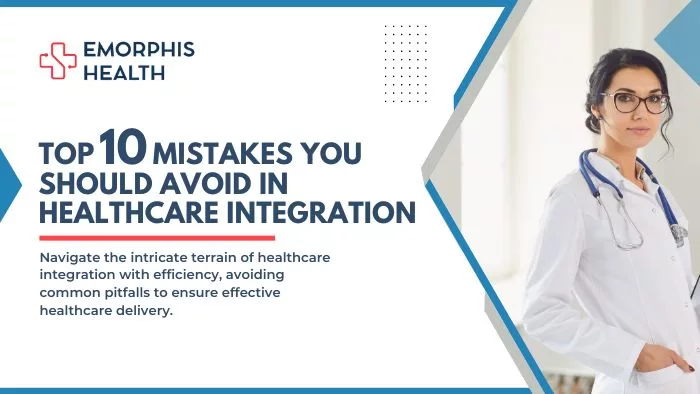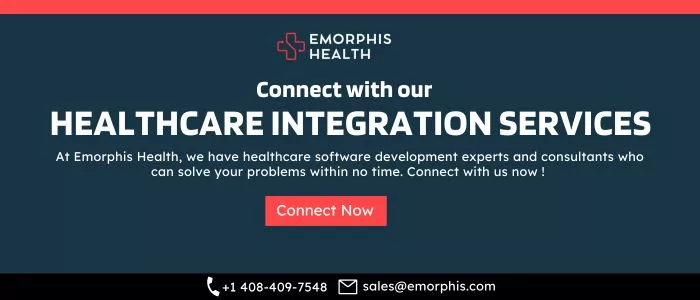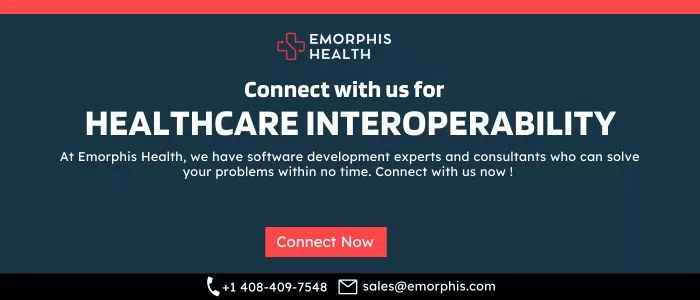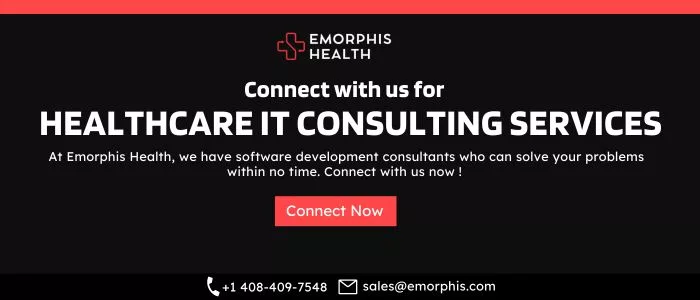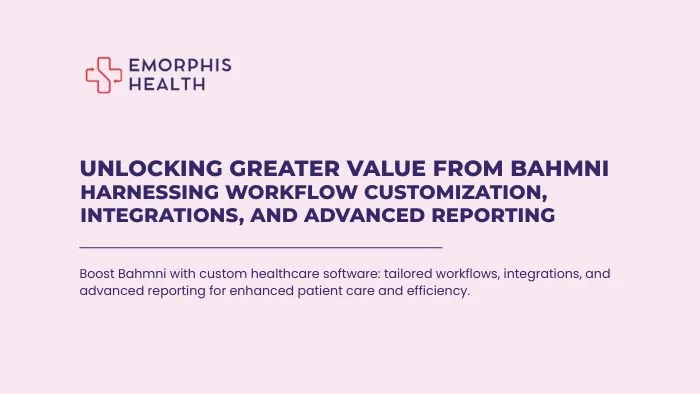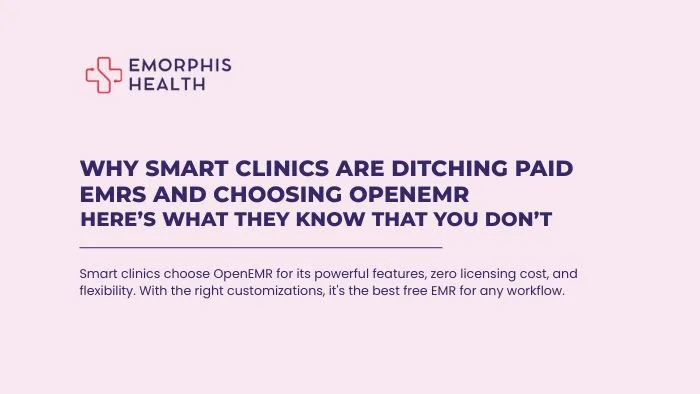Introduction
In the ever-evolving landscape of healthcare, integration has emerged as a crucial strategy to enhance patient care, streamline operations, and improve overall healthcare outcomes. As healthcare systems, organizations, and technologies continue to advance, the seamless exchange of data, resources, and services becomes paramount. However, the road to successful healthcare integration is fraught with challenges, and avoiding mistakes along this journey is imperative.
Choosing the Right Integration Model
To embark on this transformative journey, the first step is selecting the most suitable integration model. Transitioning from the overarching introduction to this critical aspect, we’ll delve into the intricacies of different integration models and the common mistakes healthcare stakeholders often make when choosing among them. Understanding these models is akin to selecting the right vehicle for a cross-country trip – the choice impacts the entire journey’s success. In this section, we will explore these models and emphasize the importance of a carefully considered decision.
Find details on AI software development
Understanding Different Integration Models
Integration in healthcare can take various forms, each with its unique advantages, disadvantages, and complexities. Before delving into the common mistakes, let’s take a moment to understand the primary integration models healthcare organizations often encounter.
A. Point-to-Point Integration
This model involves creating direct connections between individual systems, allowing them to communicate and share data. It’s like setting up multiple telephone lines between specific departments in a hospital. While it offers simplicity, it can become unwieldy as the number of connections increases.
B. Hub-and-Spoke Integration
In this model, a central hub acts as an intermediary, facilitating communication between various systems (the spokes). Think of it as a central airport hub connecting flights from multiple cities. This approach can streamline data flow but may still lead to a degree of complexity at the hub.
C. Enterprise Service Bus (ESB) Integration
ESB acts as a central nervous system for data exchange. All systems connect to the ESB, and it routes data to the appropriate destinations. Imagine a control center managing traffic in a bustling city. While this approach provides robust control and flexibility, it can be resource-intensive to set up and maintain.
D. Federated Integration
In federated integration, systems retain their independence but adhere to standardized protocols and communication methods. It’s akin to a group of diplomats from different nations working together based on shared agreements. Federated integration preserves autonomy while fostering collaboration.
Now that we have a grasp of the various integration models and their characteristics, let’s explore the common mistakes that healthcare organizations should be wary of when selecting the most appropriate model for their unique needs.
10 Mistakes to Avoid in Healthcare Integration
1. Lack of Clear Goals and Objectives
Now that we’ve explored the critical aspect of choosing the right integration model, let’s transition to another pivotal factor in healthcare integration: the importance of having clear and well-defined goals and objectives.
The Significance of Well-Defined Goals
Clear and well-defined goals are the North Star guiding any healthcare integration initiative. They form the bedrock on which the entire project rests. Just like a ship without a destination risks drifting aimlessly, healthcare integration efforts without established goals may lead to confusion and inefficiency. These goals provide a shared vision for all stakeholders, aligning efforts toward a common purpose. Without them, it’s challenging to measure progress, evaluate success, and ensure that integration efforts are in sync with the broader organizational mission.
Common Pitfalls in Goal Setting
However, despite their importance, healthcare organizations frequently stumble when setting goals for integration projects. One common pitfall is setting vague, nebulous objectives that lack specificity. Imagine trying to navigate a complex maze with no clear directions; the result is often frustration and wasted effort. Similarly, vague goals in healthcare integration can result in ambiguity, misalignment, and project drift.
Neglecting to engage essential stakeholders in the goal-setting process is another prevalent error. It’s like planning a party without considering the preferences of the guests. When stakeholders’ input is not taken into account, goals may not reflect the real needs and priorities of the organization, leading to resistance and disengagement.
Strategies for Setting SMART Objectives
To avoid these pitfalls, healthcare organizations should embrace the SMART framework for goal setting: Specific, Measurable, Achievable, Relevant, and Time-bound. This approach ensures that goals are crystal clear, quantifiable, realistic, aligned with organizational objectives, and time-limited.
- Specific: Goals should be precise and clearly articulated. Rather than stating a vague goal like “improve patient care,” a specific goal might be “reduce emergency room wait times by 20% within the next six months.”
- Measurable: Effective goals are measurable, allowing progress to be tracked and evaluated. Using the previous example, measuring the reduction in wait times provides a clear metric for success.
- Achievable: Goals should be challenging but attainable. Setting unrealistic objectives can result in frustration and demotivation, underscoring the importance of finding an equilibrium between ambition and attainability.
- Relevant: Goals should align with the organization’s broader mission and strategic priorities. A goal that doesn’t contribute to the organization’s overall objectives may lead to misalignment and wasted effort.
- Time-bound: Setting a timeframe for achieving goals creates a sense of urgency and accountability. It answers the question of “when” the goal should be accomplished, adding a critical dimension to the objective.
By applying the SMART framework, healthcare organizations can ensure that their integration goals are well-defined, actionable, and tailored to drive successful integration outcomes. This approach fosters clarity, accountability, and alignment among stakeholders, ultimately enhancing the likelihood of healthcare integration success.
Having established the importance of clear goals and effective goal-setting strategies, let’s now turn our attention to another critical aspect of healthcare integration, the role of data governance.
2. Inadequate Data Governance
Continuing our journey through the complexities of healthcare integration, let’s now navigate the waters of inadequate data governance, an essential component in ensuring the success and security of integration efforts.
The Role of Data Governance in Integration
Data governance serves as the anchor that keeps healthcare integration initiatives on course. Just as a ship requires a skilled crew to ensure safe navigation, healthcare integration requires robust data governance to maintain data quality, security, and compliance. Data governance defines the rules, processes, and responsibilities for managing data throughout its lifecycle, from creation to disposal. Without a solid data governance framework, healthcare organizations risk encountering turbulent waters, including data breaches, compliance violations, and data quality issues.
Mistakes Related to Data Security and Compliance
In the realm of data governance, mistakes related to data security and compliance can have severe consequences. Healthcare organizations often fall into the trap of assuming that data security and compliance are automatic, neglecting the proactive measures needed to protect sensitive patient information. This is akin to leaving the doors of a hospital-wide open, inviting unauthorized access.
Common mistakes include insufficient access controls, inadequate encryption, and a lack of data monitoring and auditing. Neglecting these crucial elements can result in data breaches, privacy violations, and regulatory penalties. Furthermore, failing to stay abreast of evolving compliance requirements, such as HIPAA or GDPR, can lead to costly legal ramifications. Healthcare integration efforts must be underpinned by a robust understanding of data security and compliance to avoid these pitfalls.
Establishing Effective Data Governance Practices
To navigate the treacherous waters of data governance successfully, healthcare organizations must establish effective practices and protocols. This entails implementing comprehensive data security measures, including encryption, role-based access control, and regular vulnerability assessments. It also involves creating a culture of data responsibility and accountability across the organization.
Effective data governance practices require clear documentation of data policies, procedures, and standards. Regular training and awareness programs can ensure that all staff members understand their roles and responsibilities in data protection and compliance.
Moreover, healthcare organizations should leverage technology solutions that aid in data governance, such as data governance platforms and data cataloging tools. These tools can streamline data management, enhance data visibility, and support compliance efforts.
By committing to robust data governance practices, healthcare organizations can sail through the challenges of data security and compliance, ensuring that patient information remains confidential, protected, and compliant with regulatory requirements.
With data governance firmly in place, let’s navigate further into the seas of healthcare integration by addressing another critical aspect: the importance of interoperability.
3. Neglecting Interoperability
As we continue our exploration of the intricacies of healthcare integration, our next port of call is the critical issue of neglecting interoperability – a vital factor that can make or break the seamless exchange of healthcare data and services.
Why Interoperability is Crucial in Healthcare?
Interoperability stands as the cornerstone of efficient healthcare integration. It’s the bridge that enables different systems, applications, and healthcare providers to communicate, share data, and work cohesively. Just as a universal language allows people from diverse backgrounds to understand each other, interoperability in healthcare ensures that patient records, clinical data, and administrative information can flow seamlessly, improving patient care, reducing errors, and enhancing operational efficiency. Neglecting interoperability is akin to isolating healthcare islands, hindering coordinated care and potentially compromising patient safety.
Common Issues in Achieving Interoperability
Despite its undeniable importance, achieving interoperability in healthcare is a complex challenge. Healthcare organizations often encounter common issues that impede progress. One of the most prevalent problems is the existence of disparate, legacy systems that were not designed with interoperability in mind. These systems may use different data standards, formats, or communication protocols, making data exchange cumbersome and error-prone.
Moreover, a lack of standardized data exchange formats and semantic interoperability can result in data translation errors, making it challenging for healthcare professionals to interpret and use the information effectively. It’s akin to trying to understand a foreign language with no dictionary or translation guide.
Interoperability challenges also extend to issues of trust and data security. Healthcare organizations must ensure that shared data remains confidential and protected. The fear of data breaches or misuse can lead to reluctance to share critical information, hampering the benefits of interoperability.
Find details on AI software development
Overcoming Interoperability Challenges
To navigate the complexities of interoperability successfully, healthcare organizations must adopt a multifaceted approach. One key strategy is the adoption of interoperability standards and protocols, such as HL7 FHIR or DICOM, to ensure that data is structured consistently and can be easily exchanged. This creates a common language for healthcare systems.
Another crucial step is investing in interoperable EHR (Electronic Health Record) systems that adhere to industry standards. These systems should support data exchange and integration seamlessly, reducing the burden of data translation and compatibility.
Collaboration and information-sharing among healthcare stakeholders are pivotal. Forming partnerships and consortia for the development and adoption of interoperability standards can foster a more cohesive healthcare ecosystem.
Moreover, robust data governance, as discussed earlier, plays a pivotal role in ensuring data security and compliance while facilitating interoperability.
Lastly, healthcare organizations should prioritize user training and support to empower healthcare professionals to use interoperable systems effectively. Training is like providing navigational skills to sailors navigating through complex waters.
By addressing these challenges and embracing interoperability, healthcare organizations can enhance patient care, streamline operations, and ensure that critical information flows freely and securely across the healthcare landscape.
Now that we’ve explored the importance of interoperability, let’s navigate further into the realm of healthcare integration by addressing another key aspect: stakeholder engagement.
Explore the complexities of healthcare interoperability, facilitating seamless data sharing, improved patient results, and enhanced care provision.
4. Ignoring Stakeholder Engagement
As our journey through the intricate landscape of healthcare integration continues, we now steer our focus toward the critical aspect of stakeholder engagement – an essential factor in ensuring the success and alignment of integration efforts.
Identifying Key Stakeholders
In the realm of healthcare integration, identifying and engaging the right stakeholders is akin to assembling a skilled crew for a challenging voyage. Stakeholders are individuals, groups, or organizations that have a vested interest in the integration project’s outcomes. Identifying these key players is a fundamental step in building a collaborative, well-coordinated team.
Healthcare integration initiatives typically involve a wide range of stakeholders, including clinical staff, IT professionals, administrators, patients, and external partners such as insurance providers or laboratories. Each stakeholder brings a unique perspective and set of priorities to the table, making it crucial to recognize and involve them appropriately.
Mistakes in Stakeholder Engagement
Neglecting or mishandling stakeholder engagement can lead to significant challenges and resistance. One common mistake is assuming that all stakeholders have the same level of interest and influence. It’s like expecting everyone on board a ship to have the same role and responsibilities. Failing to recognize the varying degrees of stakeholder involvement can result in misunderstandings, unmet expectations, and project delays.
Another pitfall is inadequate communication. Effective communication is the compass that guides stakeholders through the integration journey. Neglecting to keep stakeholders informed, engaged, and empowered can lead to a sense of exclusion and disengagement. Imagine sailing through a dense fog with no navigational instruments; it’s easy to lose one’s way.
Best Practices for Engaging Stakeholders Effectively
To chart a successful course through stakeholder engagement, healthcare organizations should adopt best practices that foster collaboration and alignment:
- Stakeholder Mapping: Begin by identifying all relevant stakeholders and their roles, interests, and influence levels. This mapping exercise provides a clear understanding of who needs to be involved and to what extent.
- Open and Transparent Communication: Maintain open channels of communication with stakeholders, providing regular updates on project progress, challenges, and successes. Transparency builds trust and keeps stakeholders engaged.
- Clear Roles and Responsibilities: Define clear roles and responsibilities for each stakeholder, outlining their contributions to the integration initiative. This transparency reduces ambiguity and encourages responsibility.
- Feedback Mechanisms: Create mechanisms for stakeholders to provide feedback, voice concerns, and make suggestions. This feedback loop ensures that their perspectives are considered and can lead to valuable improvements.
- Inclusivity: Involve stakeholders early in the planning and decision-making processes. This inclusion empowers them to take ownership of the project and align their interests with its success.
- Education and Training: Provide training and resources to stakeholders as needed, ensuring that they have the knowledge and tools to actively participate in the integration effort.
- Conflict Resolution: Develop a process for resolving conflicts and disagreements among stakeholders. Addressing issues promptly and constructively helps maintain a positive atmosphere.
By adhering to these best practices, healthcare organizations can cultivate a culture of effective stakeholder engagement, ensuring that all those involved are working in harmony toward the common goal of successful healthcare integration.
Having explored the importance of engaging stakeholders effectively, let’s navigate further into the waters of healthcare integration by addressing another critical aspect: planning and resource allocation.
5. Insufficient Planning and Resource Allocation
Continuing our journey through the multifaceted world of healthcare integration, we now turn our attention to the paramount issue of insufficient planning and resource allocation – a cornerstone in the foundation of successful integration endeavors.
The Importance of Thorough Planning
In the realm of healthcare integration, thorough planning serves as the navigational chart that guides the entire journey. Just as a seafarer plots their course meticulously before setting sail, healthcare organizations must invest time and effort in comprehensive planning to ensure integration success. Planning encompasses defining goals, timelines, budgets, roles, and milestones. It provides clarity, alignment, and a structured roadmap for the integration journey.
Without proper planning, integration initiatives risk becoming rudderless ships adrift in turbulent seas. They may encounter unexpected obstacles, resource shortages, and scope creep, which can lead to project delays and increased costs. Thorough planning helps organizations anticipate challenges and chart a course to avoid them.
Common Resource Allocation Mistakes
In the pursuit of healthcare integration, organizations often make common mistakes when allocating resources. One prevalent pitfall is underestimating the resources required for a successful integration project. It’s akin to embarking on a long voyage with insufficient provisions; the journey becomes fraught with difficulties, and the destination remains elusive.
Resource allocation mistakes can also manifest as overallocation to certain areas while neglecting others. For example, organizations may allocate excessive funds to technology acquisition while overlooking the importance of staff training and change management. Such imbalances can disrupt the equilibrium of the project, leading to inefficiencies and dissatisfaction among stakeholders.
Additionally, healthcare organizations may encounter resistance to resource allocation changes due to entrenched practices or competing priorities. It’s essential to navigate these challenges skillfully to ensure that resources are allocated optimally.
Strategies for Resource Optimization
To steer clear of these resource allocation pitfalls and optimize resource utilization in healthcare integration, organizations can implement the following strategies:
- Comprehensive Resource Assessment: Begin by conducting a comprehensive assessment of the resources needed for the integration project. This includes financial, human, technological, and infrastructure resources.
- Prioritization: Prioritize resources based on the project’s critical needs and objectives. Allocate resources in a way that aligns with the integration goals and timelines.
- Flexibility: Maintain flexibility in resource allocation to adapt to changing project requirements. Adjustments may be necessary as the project unfolds.
- Communication and Collaboration: Promote open communication and collaboration among different departments and teams involved in integration. This ensures that resources are allocated effectively and in alignment with the overall strategy.
- Monitoring and Evaluation: Continuously monitor resource utilization throughout the integration project. Regularly evaluate resource allocation to identify any areas that require adjustment or reallocation.
- Risk Management: Anticipate potential resource allocation risks and develop contingency plans to address them. Having a risk mitigation strategy in place helps ensure resource optimization, even in challenging circumstances.
- Change Management: Recognize that resource allocation changes may require change management efforts to overcome resistance. Engage with stakeholders and provide the necessary support and training to facilitate smooth transitions.
By adhering to these resource optimization strategies and recognizing the pivotal role of thorough planning, healthcare organizations can navigate the complex terrain of healthcare integration with efficiency and confidence, ultimately reaching their desired destination of improved patient care and operational excellence.
Having explored the significance of planning and resource allocation, our journey into healthcare integration leads us to another critical aspect: addressing cultural and organizational challenges.
6. Failure to Address Cultural and Organizational Challenges
Continuing our voyage through the intricate waters of healthcare integration, we now set our course towards the often-overlooked but critical topic of addressing cultural and organizational challenges. Navigating these waters successfully is paramount to the success of any integration effort.
Recognizing Cultural and Organizational Barriers
In the realm of healthcare integration, recognizing the presence of cultural and organizational barriers is akin to identifying hidden underwater currents that can steer the ship off course. Cultural and organizational factors play a pivotal role in shaping how individuals and groups within healthcare organizations perceive and respond to change.
Cultural barriers may include deeply ingrained practices, beliefs, or attitudes that resist new ways of working. For example, a hospital department may have a long-standing tradition of using paper-based records, which can hinder the transition to digital health records.
Organizational barriers, on the other hand, often manifest as structural issues within the healthcare institution. These may include siloed departments, conflicting priorities, or hierarchical decision-making processes. Recognizing these barriers is the first step in charting a course to overcome them.
Mistakes in Managing Change and Resistance
Failure to address cultural and organizational challenges can lead to resistance and friction. One common mistake in managing change is underestimating the impact of change on individuals and teams. Just as turbulent waters can unsettle passengers on a ship, significant changes in healthcare practices can disrupt the routines and workflows of healthcare professionals.
Another pitfall is the lack of effective change management strategies. Assuming that employees will naturally adapt to new systems and processes is akin to sailing through a storm without securing the ship’s cargo. Healthcare organizations must proactively manage change by communicating its benefits, providing training and support, and addressing concerns.
Resistance to change often emerges when stakeholders perceive the integration efforts as a threat to their roles or autonomy. Neglecting to involve key stakeholders in the decision-making process can exacerbate this resistance. In this case, it’s like passengers aboard a ship protesting changes in the ship’s route without being consulted.
Fostering a Culture of Integration
To successfully navigate the challenges posed by culture and organization in healthcare integration, organizations must actively foster a culture of integration. This involves several key strategies:
- Leadership and Vision: Leaders should articulate a clear vision for integration and demonstrate their commitment to it. Strong leadership provides direction and inspires confidence in the change process.
- Communication: Transparent and open communication is essential to address concerns, share progress, and reinforce the benefits of integration. It’s the compass that keeps stakeholders informed and engaged.
- Change Management: Implement robust change management strategies that involve stakeholders at all levels. Tailor these strategies to address specific cultural and organizational barriers.
- Training and Education: Provide comprehensive training and education programs to equip employees with the skills and knowledge they need to adapt to new systems and processes.
- Collaboration: Encourage collaboration and teamwork across departments and disciplines. Break down silos to promote a sense of unity and shared purpose.
- Feedback and Adaptation: Create mechanisms for gathering feedback from stakeholders and use this input to adapt integration efforts. Continuous improvement is the wind that propels the ship forward.
By fostering a culture of integration that addresses cultural and organizational barriers head-on, healthcare organizations can navigate these challenging waters more effectively, ensuring a smoother and more successful integration journey.
Having explored the importance of addressing cultural and organizational challenges, let’s continue our voyage into healthcare integration by examining the critical aspects of testing and quality assurance.
7. Inadequate Testing and Quality Assurance
As we chart our course deeper into the intricacies of healthcare integration, we now cast our gaze upon a vital but often underestimated aspect: inadequate testing and quality assurance. Just as a ship’s crew ensures all systems are in working order before embarking on a voyage, comprehensive testing, and quality assurance are essential to the success of any integration effort.
The Role of Testing in Integration
In the world of healthcare integration, testing serves as the compass that ensures the integration’s course is set accurately. Integration involves the seamless exchange of data and processes across diverse healthcare systems, and rigorous testing is the means to verify that these exchanges occur without errors or disruptions.
Testing encompasses various levels, including unit testing (examining individual components), system testing (verifying interactions between components), and user acceptance testing (ensuring that the integrated system meets user needs). Just as a ship’s captain meticulously inspects navigation instruments, healthcare organizations must test every aspect of integration to guarantee smooth sailing.
Common Testing and QA Pitfalls
Despite its pivotal role, healthcare organizations often fall prey to common testing and quality assurance pitfalls. One prevalent pitfall is insufficient testing coverage. Similar to a ship’s crew checking only some of the navigation instruments, incomplete testing can lead to undetected issues that may surface at a later, more critical stage of integration.
Another challenge is inadequate test data. Testing in healthcare integration requires realistic and diverse data scenarios to ensure that the integrated systems function correctly in real-world situations. Using unrealistic or limited test data is akin to practicing navigation in calm waters but encountering a storm at sea.
Additionally, testing and quality assurance should be continuous processes throughout the integration journey. A common mistake is treating testing as a one-time event rather than an ongoing practice. Neglecting ongoing testing can lead to issues going undetected until they become major problems.
Implementing Robust Testing and QA Processes
To navigate the challenges of inadequate testing and quality assurance effectively, healthcare organizations must implement robust processes:
- Comprehensive Test Planning: Develop a thorough test plan that covers all aspects of integration, including data exchange, workflow validation, and security testing. Define clear test cases and scenarios.
- Diverse Test Data: Ensure that test data is representative of real-world situations. Test data should encompass various patient profiles, conditions, and scenarios to validate the integration’s functionality comprehensively.
- Automated Testing: Consider implementing automated testing tools to streamline the testing process and ensure consistency in testing procedures.
- Ongoing Testing: Integrate testing into the entire integration lifecycle, from planning to post-implementation. Regularly conduct regression testing to identify and address potential issues that may arise due to system changes or updates.
- User Acceptance Testing (UAT): Engage end-users in UAT to ensure that the integrated system meets their needs and expectations. User feedback is invaluable in fine-tuning the integration.
- Security and Compliance Testing: Prioritize security and compliance testing to identify vulnerabilities, privacy concerns, and regulatory compliance issues.
- Documentation: Maintain comprehensive documentation of testing procedures, results, and any issues encountered. This documentation aids in tracking progress and addressing future challenges.
By implementing these robust testing and quality assurance processes, healthcare organizations can navigate the complexities of integration with confidence, ensuring that their systems function seamlessly, securely, and in compliance with regulatory requirements.
Having addressed the importance of testing and quality assurance, let’s continue our exploration of healthcare integration by focusing on another crucial aspect: neglecting training and education.
8. Neglecting Training and Education
As our journey through the world of healthcare integration progresses, we now direct our attention toward a fundamental yet often overlooked element: neglecting training and education. Just as a ship’s crew must be well-trained to navigate safely, healthcare integration relies heavily on proper training and education.
Training as a Key Component of Integration
In the realm of healthcare integration, training serves as the anchor that secures the success of the entire venture. Integration often introduces new technologies, processes, and workflows, and training ensures that healthcare professionals, staff, and end-users have the knowledge and skills required to use these systems effectively.
Without adequate training, healthcare organizations risk encountering treacherous waters where users struggle with new tools, workflows break down, and the benefits of integration remain unrealized. Training is the compass that guides users through the changes brought about by integration, ensuring they can navigate them successfully.
Mistakes in Training and Education Initiatives
Despite its significance, healthcare organizations frequently make mistakes in their training and education initiatives. One common pitfall is providing generic, one-size-fits-all training. Just as different voyages require different navigational skills, different healthcare roles may require tailored training programs. Neglecting role-specific training can lead to frustration and inefficiency.
Another challenge is insufficient hands-on training. Learning by doing is often the most effective way to acquire new skills. Neglecting practical, hands-on training can result in users feeling ill-prepared to use new systems or processes in real-world scenarios. It’s like expecting sailors to navigate a ship solely based on theoretical knowledge.
Furthermore, healthcare organizations may limit training to the initial implementation phase, neglecting the importance of ongoing learning and skill development. Integration initiatives may evolve, and technology may change, making continuous education crucial.
Promoting Ongoing Learning and Skill Development
To navigate the challenges of neglecting training and education, healthcare organizations should prioritize ongoing learning and skill development:
- Role-Specific Training: Tailor training programs to specific roles and responsibilities within the organization. Provide relevant, role-based training to ensure that users acquire the skills they need to perform their duties effectively.
- Hands-On Training: Incorporate practical, hands-on training sessions that allow users to interact with new systems and workflows. Encourage experiential learning to build confidence and competence.
- Continuous Education: Recognize that healthcare integration is an ongoing process. Implement ongoing education and training programs to keep users updated on system enhancements, changes, and best practices.
- User Feedback: Solicit feedback from users regarding their training experiences. Use this feedback to refine training programs and address any shortcomings.
- Documentation and Resources: Provide comprehensive training materials, documentation, and resources that users can reference as needed. These resources act as valuable navigational aids in the integration journey.
- Support Systems: Establish support systems, such as help desks or user forums, where users can seek assistance and guidance when encountering challenges or questions.
- Certification and Recognition: Offer certification programs or recognition for users who demonstrate proficiency in using integrated systems. Recognition can serve as a motivating factor for ongoing skill development.
By promoting ongoing learning and skill development, healthcare organizations can ensure that their workforce remains adaptable, proficient, and capable of navigating the evolving landscape of healthcare integration. This investment in training and education pays dividends in the form of improved efficiency, better patient care, and a more seamless integration experience.
Having discussed the importance of training and education, our journey through healthcare integration now leads us to another critical aspect: overlooking compliance and regulatory requirements.
9. Overlooking Compliance and Regulatory Requirements
As we continue our expedition through the intricate world of healthcare integration, we now set our course toward the crucial but often challenging aspect of overlooking compliance and regulatory requirements. Just as a ship must adhere to maritime laws and regulations, healthcare integration initiatives must navigate the complex regulatory landscape to ensure legality, security, and patient privacy.
Navigating the Complex Landscape of Healthcare Regulations
In the realm of healthcare integration, navigating the complex landscape of regulations is akin to steering a ship through a labyrinthine network of underwater obstacles. The healthcare industry is subject to a multitude of regulations and standards, such as HIPAA, GDPR, and FDA guidelines, that govern data privacy, security, and quality of care.
These regulations are not static; they evolve over time in response to technological advancements and changing healthcare practices. Therefore, healthcare organizations must remain vigilant and adaptable in complying with these regulations, just as a skilled captain navigates ever-changing sea conditions.
Common Compliance and Regulatory Mistakes
Despite their critical importance, healthcare organizations often make common mistakes related to compliance and regulatory requirements. One frequent pitfall is assuming that compliance is solely an IT or legal matter. Just as a ship’s captain must involve the entire crew in adhering to maritime laws, healthcare organizations should ensure that compliance awareness permeates every level of the organization.
Another challenge is underestimating the importance of ongoing compliance monitoring and audits. Healthcare integration initiatives may introduce new data flows, systems, and processes that need to align with existing regulations. Neglecting regular compliance checks can lead to non-compliance issues going undetected, potentially resulting in legal consequences.
Additionally, healthcare organizations may overlook the need for regulatory expertise within their teams or fail to engage external consultants with regulatory knowledge. Attempting to navigate the regulatory landscape without skilled guidance is like sailing through uncharted waters without a navigator.
Ensuring Compliance Throughout the Integration Process
To successfully navigate the complexities of compliance and regulatory requirements in healthcare integration, organizations should adopt comprehensive strategies:
- Regulatory Expertise: Appoint or engage experts in healthcare regulations who can provide guidance, conduct compliance assessments, and keep the organization informed about regulatory changes.
- Compliance by Design: Integrate compliance considerations into the design and planning phases of integration projects. Ensure that regulatory requirements are built into the architecture and processes from the outset.
- Regular Audits: Conduct regular compliance audits and assessments to identify any non-compliance issues promptly. Address any identified issues through corrective actions.
- Training and Awareness: Provide training and awareness programs to educate staff and stakeholders about regulatory requirements and their responsibilities in ensuring compliance.
- Data Protection Measures: Implement robust data protection measures, including encryption, access controls, and data anonymization, to safeguard patient information in accordance with privacy regulations.
- Documentation: Maintain meticulous records and documentation of compliance efforts, including policies, procedures, and audit reports.
- Regulatory Updates: Stay informed about changes in healthcare regulations and update integration processes and policies accordingly. Consider joining industry associations or forums to stay current.
By implementing these comprehensive compliance strategies and recognizing the paramount importance of regulatory adherence, healthcare organizations can sail through the regulatory complexities of integration with confidence and ensure that patient data remains secure and compliant.
Having discussed the significance of compliance and regulatory requirements, our journey through healthcare integration leads us to another critical aspect: managing vendor relationships.
Delve into the intricate realm of HIPAA, GDPR, FDA regulations, and other relevant guidelines in detail with Understanding Healthcare Compliance
10. Monitoring, Evaluation, and Continuous Improvement
As we navigate deeper into healthcare integration, our journey now brings us to the pivotal phase of monitoring, evaluation, and continuous improvement. Just as seasoned sailors continuously adjust their course based on prevailing conditions, healthcare integration efforts require vigilant monitoring and evaluation to ensure they stay on course and achieve their goals.
The Significance of Post-Implementation Monitoring
In the context of healthcare integration, post-implementation monitoring is akin to keeping a watchful eye on the ship’s navigation instruments even after setting sail. It is an essential practice that allows organizations to assess the performance of integrated systems, workflows, and processes.
Post-implementation monitoring helps identify issues, bottlenecks, and unexpected challenges that may arise as the integration takes root in the organization. It also provides insights into whether the integration is meeting its intended objectives and delivering the anticipated benefits.
Without diligent monitoring, healthcare organizations risk sailing blindly into unknown waters, where problems may go unnoticed, and opportunities for improvement may be missed.
Evaluating Integration Outcomes
Evaluating integration outcomes is a critical part of our journey. Just as sailors assess their voyage’s success upon reaching their destination, healthcare organizations must assess the success of their integration efforts.
Evaluation involves measuring key performance indicators (KPIs) that were defined during the planning phase. These KPIs could include improvements in patient care, operational efficiency, cost savings, and data accuracy, among others.
By evaluating integration outcomes, healthcare organizations can determine whether the integration initiative has delivered the expected benefits or if adjustments are needed to achieve the desired outcomes. It’s a crucial step in ensuring that the integration effort aligns with the organization’s goals and mission.
Strategies for Continuous Improvement
Continuous improvement is the compass that guides healthcare integration efforts toward ongoing success. To navigate this aspect effectively, healthcare organizations can employ several strategies:
- Regular Reviews: Conduct regular reviews of integrated systems, workflows, and processes to identify areas for improvement. Engage stakeholders to gather feedback and insights.
- Data Analytics: Leverage data analytics to gain deeper insights into integration outcomes. Analyze data to identify patterns, trends, and areas where performance can be enhanced.
- Benchmarking: Compare integration outcomes to industry benchmarks and best practices. Benchmarking provides valuable insights into areas where the organization can excel further.
- Feedback Loops: Establish feedback loops with end-users and stakeholders to gather input on their experiences with integrated systems. Use this feedback to inform improvements.
- Agile Approach: Adopt an agile approach to integration, allowing for iterative development and continuous refinement based on real-world usage and feedback.
- Change Management: Continuously assess and manage change within the organization. As integration efforts evolve, address any cultural or organizational challenges that may arise.
- Education and Training: Provide ongoing education and training to keep users up-to-date with system enhancements and changes. Ensure that users are proficient in utilizing the integrated systems effectively.
By embracing these strategies for continuous improvement, healthcare organizations can ensure that their integration efforts remain adaptive, responsive, and aligned with their evolving needs and goals.
Healthcare organizations can refine their integration processes to deliver better patient care, improve efficiency, and drive innovation in the ever-evolving healthcare landscape.
Conclusion
In conclusion, our journey through the complex landscape of healthcare integration has provided valuable insights. We’ve emphasized the critical importance of meticulous planning, effective stakeholder engagement, rigorous testing, continuous training, and unwavering compliance in achieving successful integration.
Neglecting these aspects can lead to delays and inefficiencies, affecting patient care and operational effectiveness. Looking ahead, we anticipate further advancements in interoperability, the integration of AI and machine learning, increased patient engagement, and innovative approaches to population health management. These developments hold the potential to improve healthcare delivery and outcomes for all.
The path to a more efficient and patient-focused future in healthcare integration lies in embracing these principles and constantly striving for improvement.

